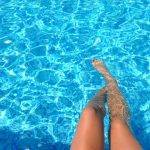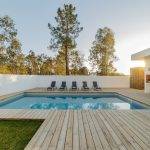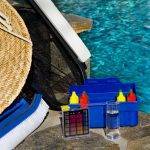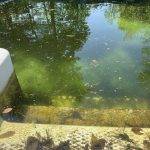The SLAM (Shock Level And Maintain) process is the best way to eliminate algae, sanitize your pool, and achieve crystal clear water. You cannot complete this process overnight! Allow for several days to finish and do not take any shortcuts! A SLAM cannot be completed unless you are willing to do your own testing with a FAS-DPD chlorine test, included in our recommended test kits and also available separately. Without that specific test, you risk wasting your time and potentially having to start all over later.
When should I SLAM?
If you have ANY of the following:
- Visible algae in your pool
- CC level above 0.5 ppm
- Loss of more than 1.0 ppm of FC overnight (see overnight chlorine loss test)
Before you start:
- Print out the SLAM process checklist and use it during your SLAM. The checklist guides you step by step and is a lot easier to refer to than going back to the phone or computer.
- You can also print out this page if that is easier.
- Download PoolMath. PoolMath will calculate chemical additions for you based on your testing.
- Obtain a FAS-DPD chlorine test, available in our recommended test kits
- Determine your current CYA level with one of our recommended test kits.
- If your CYA is between 30-70 ppm, go to the next step.
- If your CYA is less than 30 ppm, use PoolMath to determine how much dry stabilizer you need to raise your CYA to 30. Put that
recommended amount of dry stabilizer into a (human) sock or
stocking and hang it in front of a pool return (“Sock Method”). Once the sock is in the pool, your CYA = 30, and you can proceed to the next step. - If your CYA is higher than 70 ppm, drain or exchange water to reduce your CYA to 70 or lower, then continue to next step.
- Use the current CYA level from your test, or if you added CYA to raise CYA to 30, use 30 for your CYA value. Use the CYA value you wrote down and use the FC/CYA tool to determine your SLAM level FC based on your CYA. Select “SLAM my cloudy or green swimming pool”.
- If your pool holds less than 20,000 gallons, buy 10 gallons of liquid chlorine. If your pool holds more than 20,000 gallons, buy 15 gallons of liquid chlorine. It may take more, or less, to complete the process, but if you don’t use all of it you can return or use it for daily chlorination.
- Remove leaves and visible debris from the pool, as much as possible.
- Make sure your filter is working properly and you understand how to backwash and clean it out should it become necessary.
- Check and adjust the pH to between 7.2 and 7.5. The pH test isn’t reliable during a SLAM so adjust pH before you start. There’s no need to test pH, or any other levels again, until your SLAM process is completed. After SLAM, when your FC drops below 10, you can test and manage pH as normal.
- Turn off all other forms of chlorine generation, like saltwater chlorine generators, puck chlorinators, etc.
Perform the SLAM process:
- Test FC level with the DPD powder (R-0870) and FAS/DPD reagent (R-0871).
- Use PoolMath to help you to determine how much liquid chlorine you need to raise your FC from your current FC to SLAM level FC. Then, add that much chlorine to your pool. At least 3-4 times per day, repeat your testing and add chlorine back to SLAM level FC. Use PoolMath to calculate how much to add each time based on your testing.
- If you can test and add FC more often, up to every 2 hours, your SLAM will proceed faster!
- At the beginning of your SLAM, the chlorine is used quickly to kill algae. As the algae is killed off, you can reduce your testing and chlorine additions to 2-3 times per day.
- We recommend testing after sunset and at sunrise to check if algae is consuming chlorine in the absence of sunlight (see OCLT).
- Brush the entire pool once a day if you can. Brush inside skimmers, under main drain covers, on weir doors, inside ladders, and behind removable lights if applicable.
- Backwash or clean the filter when filter PSI increases by 25% over your clean filter pressure.
- If you have a vacuum, use it to vacuum up debris as needed.
- You can safely swim in your pool during SLAM if you can see the bottom of the deep end AND your FC is between minimum and SLAM level (per FC/CYA tool).
- Run the pump 24/7 until you are done SLAMing.
- There is no need to run any other water tests other than FC during your SLAM. When you pass your OCLT, test that sample for CCs.
Finish the SLAM:
Once all three of these criteria are met, you have completed the SLAM process and can allow FC to drop to normal levels.
- CC is 0.5 or lower
- AND your overnight chlorine loss test shows 1.0 ppm of loss or less
- AND pool water is crystal clear with no visible sign of algae (dead or alive) on floor and walls
Additional Notes:
In the first few days of a SLAM, testing and adding chlorine more frequently can be beneficial to closely maintain SLAM FC level. We recommend 3 times daily at a minimum: morning, noon, and night. If your schedule permits, you may test and add chlorine as often as every 2 hours.
SLAMing an outdoor pool is easiest and most effective when CYA is around 30 to 40. Below 30, you lose too much free chlorine to sunlight. As CYA goes up, SLAMing requires more and more chlorine, which starts to get impractical around 80 or 90. With CYA above 90 we recommend replacing water to decrease CYA before you start the SLAM process.
Depending on what kind of filter you have, it can take the filter a week or more to completely clear the water, even after all of the algae is dead. DE filters are usually much faster than that, but also require more frequent attention. Sand filters are the slowest, and cartridge filters are somewhere in-between. Nevertheless, each filter will get your pool crystal clear.
While SLAMing, the appearance of the water should improve each day, though perhaps only by a little. If you fail to see any improvement you might have a problem with your filter, you might have a higher CYA level than you think, you might have poor water circulation, or you might have some other more complex problem. Start a thread on our forums and we can offer you personalized advice.
The goal of SLAMing is to add enough chlorine to oxidize all of the algae, combined chloramines, bacteria, viruses, ammonia, and other organic contaminants. Oxidation breaks down the organic molecules into smaller parts which are harmless. When SLAMing, you need to keep adding chlorine until the breakdown process is complete.
Higher FC levels will oxidize contaminants more quickly, but levels that are too high can cause damage to the pool or the pool equipment. Our SLAM FC levels are designed to break down contaminants quickly while posing no risk to the pool or anyone swimming in it. It is impossible to know in advance just how much chlorine will be required to SLAM the pool. Instead, chlorine is added to maintain SLAM level until testing shows that the process is complete.
Though your free chlorine levels may seem high, you can safely swim in your pool so long as you can see the bottom and your FC is between minimum and SLAM level. This means that you can safely enter your pool to scrub hard to reach places even at SLAM FC. If you exceed SLAM FC, we recommend allowing the FC to drop to SLAM level before swimming.
If you have a salt water chlorine generator, chlorine tablet dispenser, injection pump, or Liquidator, turn it off for the duration of the SLAM process. SLAM by adding liquid chlorine only for best results.
If you have a sand filter, you can speed up the process by adding a little pool-grade DE to your filter. See Add DE to a sand filter for more information.
If you have questions that aren’t covered here, start a thread on our forums and our experts and guides will assist you quickly.





